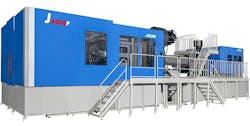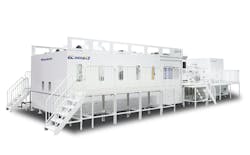Large electric injection molding machines find competitive niche
Key points in this article:
-
Big electric IMMs debut globally — LS Mtron, JSW, and Shibaura launch 1,500- to 4,400-ton all-electric presses.
-
Sustainability advantages — New electrics cut energy use by up to 70 percent and slash emissions compared to hydraulics.
-
Market applications expand — Tote manufacturing, EV components and large industrial parts drive demand for big-tonnage electrics.
-
Efficiency & precision gains — Advanced screws, faster cycles and servo-driven control boost productivity while reducing operating costs.
-
U.S. processors investing now — Evco Plastics and others adopt high-tonnage electrics to lower energy bills and meet environmental goals.
By Karen Hanna
Think a servo or all-electric design makes sense only for small injection molding machines (IMMs)?
Think again.
If the words “big” and “hydraulic” pair as well as for you as “micro” and “medical,” at least three injection molding machine (IMM) makers just might challenge some long-held assumptions. Electric is living large.
As of mid-August, LS Mtron was preparing to deliver its largest-ever all-electric — a 1,500-tonner it hopes will be turning heads in a few years at NPE2027. In June, Japan Steel Works debuted its 4,400-ton electric J4000F-22000H. Shibaura also is among OEMs offering huge electrics — at the K show, it plans to show off its EC-SXIII All-Electric series, which includes a machine tipping the scales with a top clamping force of 3,350 tons.
Shigetomo Sakamoto, president of Shibaura Machine Group, noted his company’s achievements with the EC-SXIII All-Electric series, which includes the behemoth EC3000SXIII model. The company will show the series off at the K show, along with the S-GenXt Hydraulic series.
“With the new EC-SXIII All-Electric and S-GenXt Hydraulic series, we’re redefining injection molding,” he said. “These machines enhance performance, precision and operational efficiency, driving smarter and more economical production. At the same time, we’re advancing our capabilities in digitalization and sustainability.”
The place for big electrics
Like smaller electrics, big electrics boast a bevy of sustainability advantages, according to Paul Caprio, president of sales for LS Injection Molding Machine North America: They’re faster and cleaner, with no oil that can spill and must be replaced.
So, the benefits are typical. But the machine sizes for all-electrics are not. At least not yet.
"We’re delivering a 1,430 (-ton), all-electric machine. That’s a brand-new model to us. It’s our largest all-electric machine, and it’s going to a tote manufacturer,” Caprio said.
Among tote manufacturers, who need high-performance capabilities even at bigger sizes, he said he’s seeing a new dynamic: The cost of tricking out hydraulics or hybrids to make them run in the ways users want is dampening any price advantages they might ordinarily have over electrics.
Within the tote manufacturing market, all-electrics can prove to be cost-competitive.
“What we are focusing on in this tote market is the lion’s share of the machinery in that market is hydraulic, and the newer machines are servo-hydraulic, but we find they’re all-high-performance machines, which means they’re not inexpensive machines. They’re actually an expensive purchase,” Caprio said.
Shibaura prepares K show splash
In a video touting its EC30000SXIII, Shibaura says, “it is important to improve both energy efficiency and production efficiency in the manufacturing processes.”
Because big machines draw so much power, Chuck Gorman, Shibaura’s national sales manager and deputy GM for injection molding, said electric machines’ efficiency can make a significant difference when major clamping forces are required.
According to the video, the EC3000SX uses 70 percent less power than conventional hydraulic injection molding machines. By reducing power usage, the IMMs manage to put out fewer emissions — up to 161 pounds less per year than comparable hydraulics. They also need far less hydraulic fluid, cooling water and grease.
The machines feature Shibaura’s new ESB screw, which enables speeds of about 164 feet per minute— 47 percent faster than conventional screws.
The video also boasts of fast dry-cycle times and mechanisms that make die changes easier and faster.
According to the video, “the ESB screw and cross ring enable stable plasticization of large volumes of resin in a short time for boosting production capacity.”
With the EC 3000 SX machines, Shibaura said manufacturers can take a greener approach to molding.
“We believe that converting from hydraulic to electric machines can make a significant contribution to reducing your environmental impact," the video states.
JSW goes big
When Evco Plastics installed a 3,305-ton JSW J3000F two-platen electric IMM in the fall of 2023, Anna Bartz, VP of communications for the Wisconsin-based processor, said it was looking to cut its energy usage. In an email, she called the machine a "a game changer."
"Our decision to pursue the JSW was based on our corporate vision to become a better steward of our environment and to make a BOLD statement on energy efficiency. This press requires one-quarter of the energy supply compared to our other presses in this size range. The controllability of the full servo-driven injection unit makes this press as accurate as a new fully electric 1,000-ton."
But the J3000F is not JSW's biggest in its stable of electric machines. Like LS Mtron and Shibaura, the OEM is going big, to meet the demand for lighter components for electric vehicles, among other applications.
In a press release introducing its 4,400-ton IMM, the company noted the drawbacks of hydraulics and said, “we have adopted an electric system, which allows us to achieve high productivity, energy efficiency and high quality, and differentiates us from other companies with our unique long-life, robust design.”
Compared to hydraulic systems, the machine uses 15 percent to 20 percent less power, half as much cooling water and only 30 percent as much hydraulic oil consumption. Reductions in emissions and operating costs can range up to 20 percent or more.
To help customers handle shipping concerns, the company has announced it maintains IMMs with up to 1,000 tons of clamping force in stock in New Jersey.
Weighing the benefits of electrics
After it takes delivery of its 1,430-tonner, the customer that’s made an investment in LS Mtron has told its supplier it will share the results.
The molder already has both servo-hydraulics and smaller electrics, Caprio said.
“Most of the machines that customer runs [are] servo-hydraulic, and we’re all very interested to see, what will an all-electric machine give them here, in terms of output, energy usage, utilization of water capacity from their water system?” he said.
While he’s eager to hear the breakdown, Caprio expressed confidence in how the new machine will perform — even with big parts.
“What usually happens is you have customers that, if they get exposed to the all-electric, they tend to fall in love with that," he said.
About the Author
Karen Hanna
Senior Staff Reporter
Senior Staff Reporter Karen Hanna covers injection molding, molds and tooling, processors, workforce and other topics, and writes features including In Other Words and Problem Solved for Plastics Machinery & Manufacturing, Plastics Recycling and The Journal of Blow Molding. She has more than 15 years of experience in daily and magazine journalism.

